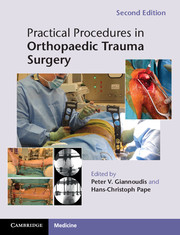Book contents
- Frontmatter
- Dedication
- Contents
- List of Contributors
- Preface
- Acknowledgements
- Part 1 Shoulder girdle
- Part 2 Upper extremity
- Part 3 Pelvis and acetabulum
- Part 4 Lower extremity
- 10 Section I: Extracapsular fractures of the hip
- 11 Section I: Fractures of the femoral shaft
- 12 Fractures of the patella
- 13 Section I: Fractures of the proximal tibia
- Section II: Fractures of the tibial shaft
- Section III: Fractures of the distal tibia
- 14 Fractures of the ankle
- 15 Fractures of the foot
- Part 5 Spine
- Part 6 Tendon injuries
- Part 7 Compartments
- Index
Section III: Fractures of the distal tibia
Published online by Cambridge University Press: 05 February 2014
- Frontmatter
- Dedication
- Contents
- List of Contributors
- Preface
- Acknowledgements
- Part 1 Shoulder girdle
- Part 2 Upper extremity
- Part 3 Pelvis and acetabulum
- Part 4 Lower extremity
- 10 Section I: Extracapsular fractures of the hip
- 11 Section I: Fractures of the femoral shaft
- 12 Fractures of the patella
- 13 Section I: Fractures of the proximal tibia
- Section II: Fractures of the tibial shaft
- Section III: Fractures of the distal tibia
- 14 Fractures of the ankle
- 15 Fractures of the foot
- Part 5 Spine
- Part 6 Tendon injuries
- Part 7 Compartments
- Index
Summary
Indications
Displaced intra-articular fractures with > 2 mm gap or step.
Fractures with significant displacement of the metaphysis.
Reconstructable fractures (joint fragments that are large enough to hold small-fragment screws). In cases where ORIF is not feasible an ankle fusion is an alternative option.
Compartment syndrome.
Preoperative planning
Clinical assessment
Mechanism of injury (fall from a height, skiing injury, motor vehicle accident, forward fall with a trapped foot).
Look for associated injuries.
Thoroughly assess the soft tissue condition.
Look for the presence of an open injury.
Assess the neurovascular status of the extremity.
Look for early signs or symptoms of compartment syndrome.
Review patient's past medical history and recognize the existence of medical conditions (diabetes, osteoporosis, vascular disease) that can modify the plan of treatment.
Displaced or dislocated fractures must be reduced immediately.
Radiological assessment
Standard high-quality anteroposterior, lateral, 45 degrees external rotation and mortise views of the ankle (Fig. 13.6.1).
The standard initial anteroposterior radiograph is very useful for the understanding of the mechanism of injury and the type of the deinitive surgical ixation to be implemented.
CT scan (two- and three-dimensional): provides information regarding the fracture pattern, the number and location of the cortical fragments, the extent of articular comminution, the amount of articular displacement and the further planning of the surgical technique. The CT scan should be performed after the application of the ex-fix (Fig. 13.6.2).
- Type
- Chapter
- Information
- Practical Procedures in Orthopaedic Trauma Surgery , pp. 361 - 384Publisher: Cambridge University PressPrint publication year: 2014



